In order to thrive in today’s rapidly changing world, children need rich learning opportunities in and out of school that allow them to adapt and engage in independent and lifelong learning. An overwhelming body of evidence points to play as the best way to equip children with a broad set of flexible competencies and personal capacities to tackle new and different challenges creatively. Moreover, studies show that quality play-based education has a high return on investment in the form of higher earnings, reduced crime, and other social indicators. And yet, today, children have less time for play in and out of school as parents and educators increasingly worry about academic readiness.
As highlighted in a recent Brookings report on education reform, playful learning in school is a low-cost, flexible, and equitable approach that ensures all students receive the educational experiences necessary to become critical thinkers and engaged problem solvers. Playful learning also promotes 21st century skills outside traditional school settings. Playful Learning Landscapes (PLL)—an initiative that blends the science of learning, placemaking, and community cohesion—shows that everyday public spaces can be transformed into engaging learning hubs.
These PLL objectives are embedded in the new Urban Play Framework (UPF) featured in the “Reclaiming play in cities” report. Based on a review of literature from sociology, child development, and educational theory and consultations with play scholars, the UPF was developed by Arup in collaboration with the LEGO Foundation and the Royal Town Planning Institute for the Real Play Coalition. Urban childhoods are the future—by 2050, experts predict that around 70% of the world’s population will live in cities. Yet many cities continue to ignore the needs of children and their caregivers. The UPF aims to address this challenge by supporting the design of play-based interventions in urban spaces to maximize the chance for children to engage in play as part of their daily routine.
The Urban Play Framework
The intersection of play, playful learning, and the built environment is a nascent but growing field of research centered around how investments in the public spaces and placemaking can promote children’s play and playful learning to support their holistic and healthy development. But to date there has been limited guidance on how to design neighborhoods that encourage play beyond playgrounds and consider all of the environments in which children spend time, including public spaces. The UPF helps fill this gap by bringing together the disparate fields of play and placemaking to better understand the complexity of play in cities and provide actionable guidance in a simple and holistic framework (Figure 1).
Figure 1. Urban Play Framework
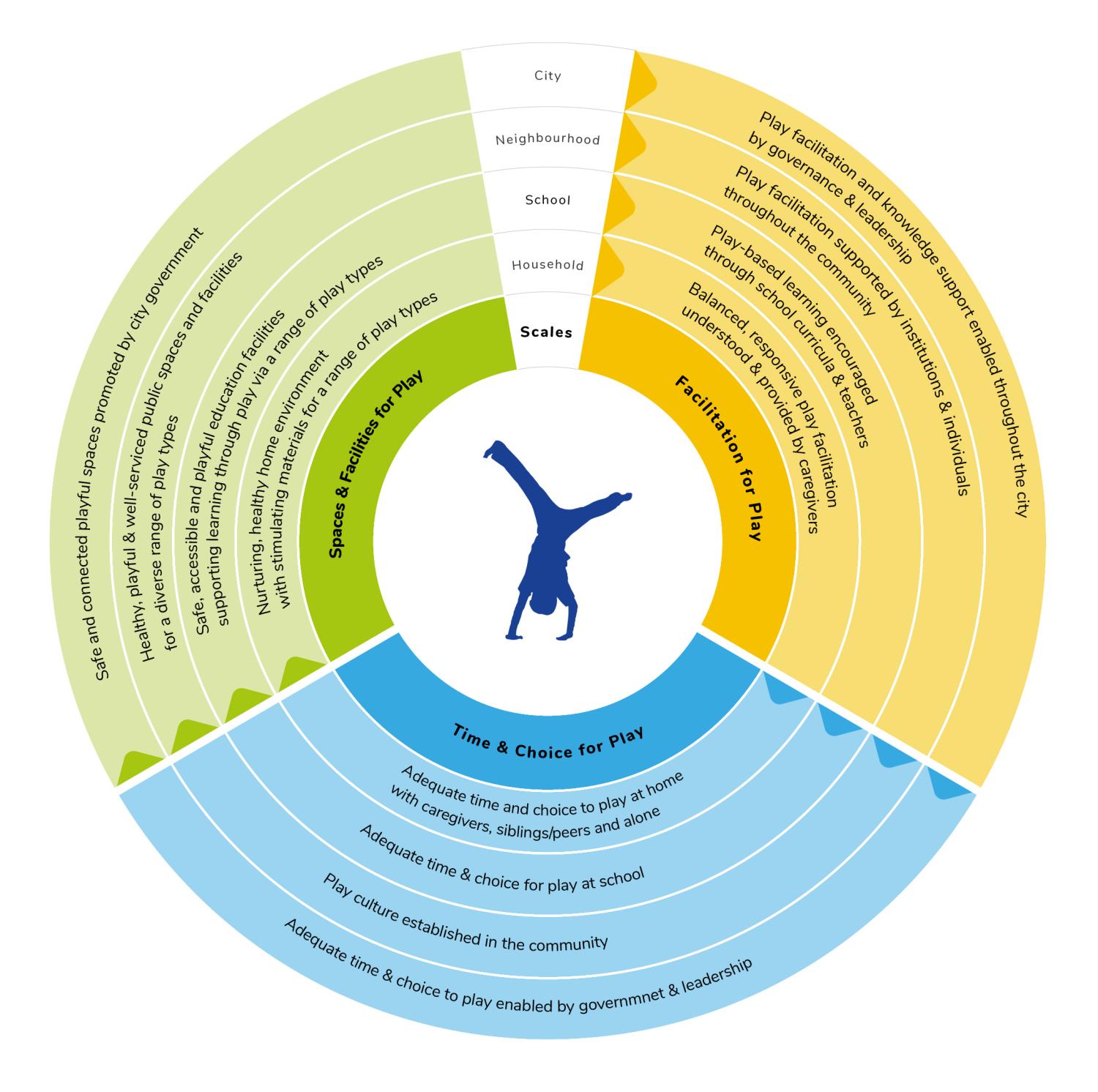
Three key dimensions to promote playful learning and optimal child development
The UPF is organized around three key dimensions that are critical for designing play-based interventions to support child development and learning:
- Time and choice. This dimension centers around providing adequate time for children to play and opportunities for child-led play. Research conducted by the Real Play Coalition indicates that while children and families want more play in their lives, it is increasingly difficult to find the time when children are overscheduled and distracted by multiple forms of technology and parents are balancing busy work-lives. With respect to choice and agency in play, both anecdotal and experimental evidence support the benefits of active or “minds on” learning—where children are focused and engaged in the learning process through questioning and reflection—over passive learning where students listen and memorize information. Active learning highlights children’s agency in play and the important role of choice in the learning process.
- Space and facilities. This dimension seeks to understand if children have access to a safe space, variety of facilities, and range of toys and creative materials to engage in different play types (e.g., physical play, pretend play, and games). Cities aren’t well designed for children and their families, and safe spaces for children to play unsupervised are often hard to find. Designers, city planners, community leaders, and behavioral scientists are working on cross-disciplinary strategies—like PLL—for converting densely populated environments into people-friendly habitats that support healthy living. Resources and publications including “The City at Eye Level for Kids,” “Designing Streets for Kids,” and “Cities Alive: Designing for Urban Childhoods” highlight the importance of designing streets and other public spaces so they are safe and more joyful for children and their caregivers.
- Facilitation. This dimension focuses on adults’ roles (caregivers, teachers, community members, and city leaders) in supporting children’s learning and development through facilitated play, which can take the form of free play or guided play. While free play (child initiated and directed) is important and contributes to a range of positive developmental outcomes, evidence shows that guided play—a type of play where an adult initiates or designs an activity that is centered around a learning goal but the child maintains control over the learning—is an effective approach for strengthening a range of critical skills. The “Playful Learning Landscapes Playbook” takes a deep dive into the benefits of guided play and describes how this research can inform practice in urban spaces.
A systems approach to understanding play in cities
The UPF illustrates how the three dimensions detailed above can be applied in a range of contexts and levels: (1) the household; (2) the school; (3) the community; and (4) the city. These levels and contexts should be designed such that play permeates children’s lives—in “traditional environments” like homes, schools, and playgrounds, as well as in spaces that are not usually considered safe or appropriate for children to play (e.g., streets and vacant lots) but that in fact could be reimagined to provide play opportunities.
The many benefits of play in a home or non-school environment have been well documented and include improvement in cognitive skills (executive function, early math, and language), social and emotional development, and physical development. The value of playful learning in school challenges the false dichotomy between play and formal learning. In a recent Brookings report, Hirsh-Pasek and colleagues advocate for playful learning in schools as the ideal path for education reform that prepares children to thrive.
Findings from PLL pilots in cities across the U.S. speak to the benefits of play in a neighborhood and city context, as well. Research on PLL installations shows that PLL promotes the kind of caregiver-child communication that supports language learning and relationship building, encourages children’s talk about numbers, letters, and spatial relations, and increases caregivers’ attitudes about the connection between play and learning. For example, PLL’s Urban Thinkscape in Philadelphia infused a bus stop with learning by adding puzzles to a bench and transforming the childhood-favorite hopscotch into an executive function activity.
A call to action for designing playful cities
Public, private, and civic sector leaders need to embrace and prioritize play in their communities so new ideas can be implemented, measured and evaluated, and scaled. The UPF helps do this by providing much-needed guidance for urban planners, designers, and practitioners seeking actionable ways to design play-based interventions to build more family-friendly cities. The UPF has been field tested and further refined in London and Cape Town and is being applied in Milan in 2021. As its use expands, a key next step will be for the field to start attaching measures and indicators to this framework, which will help city leaders set measurable goals and track progress over time toward those goals. By thinking differently about the role of play in cities, we can optimize learning for children while at the same time enhancing urban environments for all citizens.
The Center for Universal Education receives funding from the LEGO Foundation. The views expressed in this blog are solely those of the authors.
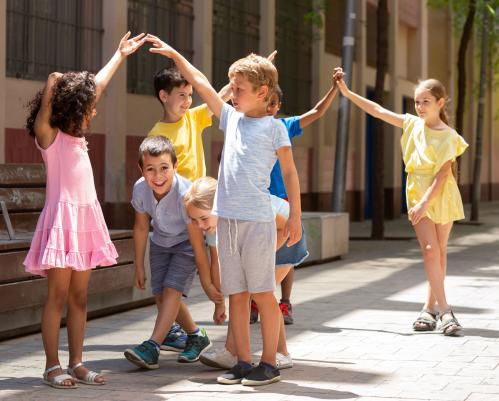
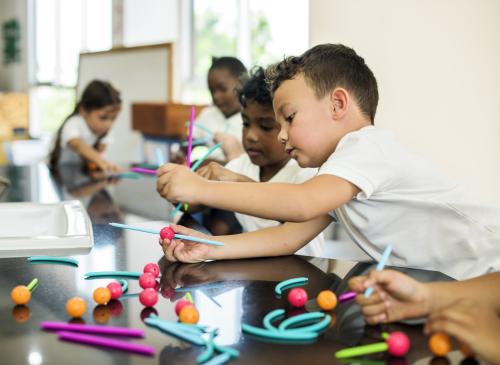
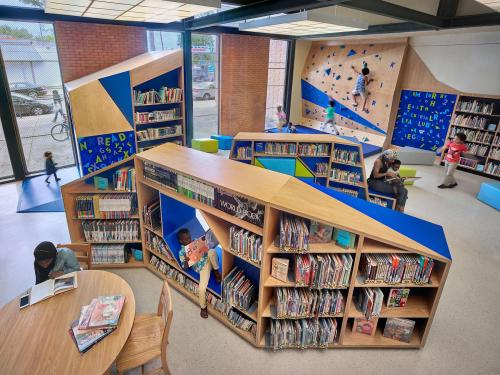
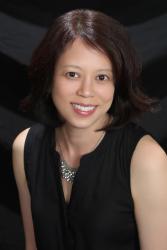
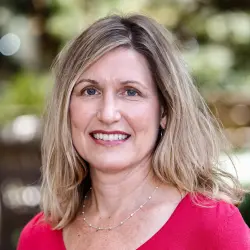



Commentary
The Urban Play Framework: An approach for understanding the play experience in cities
January 27, 2021